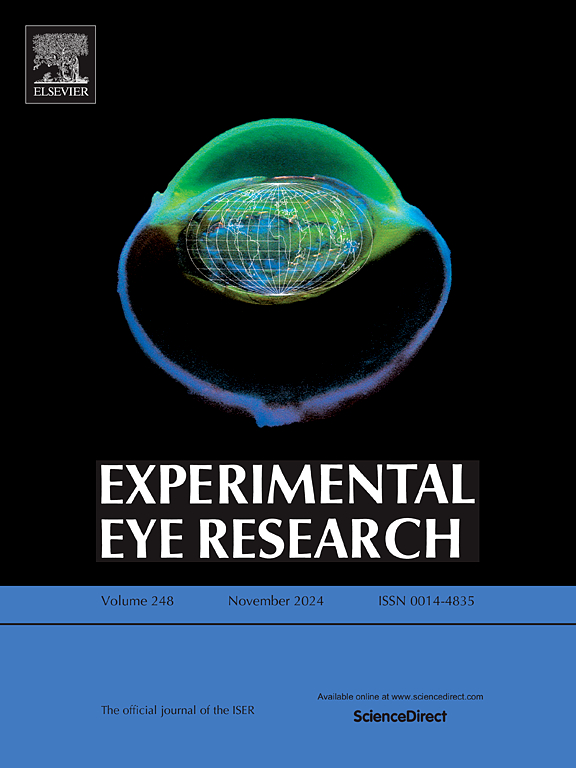NLRP3蛋白易位介导SV40 t抗原诱导的角膜上皮细胞永生化。
IF 3
2区 医学
Q1 OPHTHALMOLOGY
引用次数: 0
摘要
NLRP3蛋白主要在细胞质中作为炎性体的核心成分,但在某些情况下,如在人类单纯病毒(HSV)感染的角膜中,在SV40 T- ag永活的人角膜上皮细胞(HCEC)系中,或在naïve T细胞分化过程中,很少记录到转运到细胞核中。本研究旨在确定SV40 T-Ag转染本身是否或如何导致NLRP3易位。结果表明,编码SV40 T-Ag的慢病毒感染原代人角膜上皮细胞可诱导NLRP3蛋白易位进入细胞核。对HCEC核蛋白中含有NLRP3的复合物进行拉下分析,质谱分析发现285种核蛋白与NLRP3蛋白相互作用。对这些蛋白进行聚类分析,发现“RNA结合”、“核胞质转运”和“病毒致癌途径”是富集的分子功能项或KEGG途径。结构建模显示NLRP3蛋白和组蛋白亚基之间有显著但不同的亲和力。利用SELEX (systematic Evolution of Ligands by EXponential enrichment)来确定NLRP3蛋白在体外可能结合的DNA基序,对SELEX基序的深入分析证实,包含这些基序的基因与转录和RNA加工显著相关。本研究表明,在SV40 t - ag介导的角膜细胞永生化过程中,NLRP3蛋白易位到细胞核中,并发挥转录因子的作用。除了证实NLRP3蛋白在非免疫细胞或角膜等组织中的新功能外,这些发现还揭示了病毒介导的永生化或病毒诱导的致癌机制。本文章由计算机程序翻译,如有差异,请以英文原文为准。

NLRP3 proteins translocation into nuclei mediates SV40 T-antigen-induced corneal epithelial cell immortalization
NLRP3 proteins mainly act as inflammasome core components in cytosol, but was sparsely recorded to translocate into nuclei in some conditions, such as in human simplex virus (HSV)-infected corneas, in SV40 T-Ag-immortalized human corneal epithelial cell (HCEC) line, or during differentiation of naïve T cells. This study was designed to define whether or how SV40 T-Ag transfection per se caused NLRP3 translocation. It was demonstrated that infection of primary human corneal epithelial cells with lentivirus coding for SV40 T-Ag induced NLRP3 proteins' translocation into nuclei. Pull-down of NLRP3-containing complexes in HCEC nuclear proteins followed by mass spectrometry revealed 285 nuclear proteins interacting with NLRP3 proteins. Clustering analysis of these proteins showed that “RNA binding”, “Nucleocytoplasmic transport” and “Viral carcinogenic pathway” were among the enriched molecular function terms or KEGG pathways. Structural modeling showed significant but differential affinities between NLRP3 proteins and histone subunits. Systemic Evolution of Ligands by EXponential enrichment (SELEX) was utilized to define DNA motifs potentially bound by NLRP3 proteins in vitro, and in-depth analysis of SELEXed motifs confirmed that the genes harboring those motifs were significantly associated with transcription and RNA processing. This study demonstrated that during the process of SV40 T-Ag-mediated corneal cell immortalization, NLRP3 proteins translocated into nuclei and behaved like a transcription factor. Besides confirming NLRP3 proteins’ novel functions in non-immune cells or tissues like cornea, these findings also shed light on the mechanisms of virus-mediated immortalization or viral induced carcinogenesis.
求助全文
通过发布文献求助,成功后即可免费获取论文全文。
去求助
来源期刊

Experimental eye research
医学-眼科学
CiteScore
6.80
自引率
5.90%
发文量
323
审稿时长
66 days
期刊介绍:
The primary goal of Experimental Eye Research is to publish original research papers on all aspects of experimental biology of the eye and ocular tissues that seek to define the mechanisms of normal function and/or disease. Studies of ocular tissues that encompass the disciplines of cell biology, developmental biology, genetics, molecular biology, physiology, biochemistry, biophysics, immunology or microbiology are most welcomed. Manuscripts that are purely clinical or in a surgical area of ophthalmology are not appropriate for submission to Experimental Eye Research and if received will be returned without review.
 求助内容:
求助内容: 应助结果提醒方式:
应助结果提醒方式:


